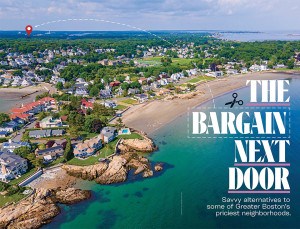Buying the Farm on Martha’s Vineyard
The seeds of the Vineyard’s local-food movement predate the popularization of the word “locavore.” In May 2005, Ali Berlow, copublisher of the magazine Edible Vineyard and producer of a public radio show called A Cook’s Notebook, invited a few dozen people representing different sectors of what she called the island’s “food web” to a potluck dinner at her Vineyard Haven home. Berlow’s invitation was accepted by a handful of farmers, along with Steve Bernier, owner of the local grocery chain Cronig’s Market; Armen Hanjian, the coordinator of Island Food Pantry, which provides staples for the needy out of a Vineyard Haven Methodist church; and an assortment of chefs and cookbook authors. The group’s interests dovetailed with an emerging national conversation about food and where it comes from. Over short ribs prepared by Berlow’s good friend, chef and James Beard Award–winning author John Ash, they came up with a plan to support local farmers, with the ultimate aim of increasing the proportion of local food in the Vineyard’s diet.
First on the agenda was marketing local growers, with a map that would direct tourists to Vineyard farm stands. Bernier volunteered to distribute the guide at Cronig’s Market; while it would direct customers to his ostensible competition, it was good PR for the supermarkets. Once its directory of island growers was complete, the group, by then calling itself Island Grown Initiative, decided to tackle obstacles that were preventing food from moving smoothly between farm and table. In conversations with farmers, they learned that one of the major issues was access to a slaughterhouse.
There are several farms on the Vineyard that raise animals for meat, and meat can fetch a premium when it’s labeled “local.” But while the animals may be born and raised on the island, when a Vineyard-raised steak is served at a Vineyard restaurant, it could have up to twice the carbon footprint of a steak sourced from the mainland. That’s because animals are currently trucked off-island for slaughter in Rhode Island or Connecticut, or at one of Massachusetts’ two USDA-monitored slaughterhouses, in Athol and Groton, each more than two hours away by car (not including time on the ferry).At first an on-island abattoir for four-legged animals was deemed too ambitious for the fledgling nonprofit, so Island Grown settled on a mobile chicken-slaughtering operation, which could be pulled behind a pickup truck and made available for a fee to farmers and backyard growers. This program, which began in 2007, was a big success, helping to increase the number of birds raised on the Vineyard from about 200 to 10,000 by 2015. Next up came a gleaning program, in which volunteers harvest crops left over after the season ends and donate them to schools and social service agencies (last year alone, some 24,000 pounds were gleaned), and Island Grown Schools, a program that educates children about food and farming. By 2012, Island Grown Initiative was a major player in Vineyard agriculture—and well positioned to take on an even bigger role. That year, it bought Thimble Farm.
Local farmers had long considered Island Grown an ally, but they watched the Thimble Farm operation with trepidation. At a meeting with about 30 local farmers, the non-profit’s leadership promised that it would not sell produce. According to public statements from Steve Bernier, the grocery-chain owner and an Island Grown board member, that promise was written into their bylaws. But Wilda’s greenhouse operation did so well that by 2014 Island Grown was selling to restaurants and CSA members directly, and even to Bernier’s Cronig’s Market. Bernier himself acknowledged a conflict of interest, saying Island Grown’s CSA competed with his own stores, and so he resigned from the board this year.
Bernier’s influence is still felt, especially since Island Grown’s new president is Sarah McKay, formerly the market chain’s longtime manager. And because farmers rely on Cronig’s Market to distribute their goods, they worry that angering Island Grown could be dangerous. But they’re resentful to find themselves under the shadow of an operation that has access to millions of dollars in off-island funds.
“Do real farmers have to compete with a nonprofit that’s begging tons of money?” Arnie Fischer asks, as he shows me around his 120-acre Flat Point Farm, where along with the sheep he keeps some milk goats, a few dozen laying hens, and a handful of beef cows. In a shabby barn that smells of hay and droppings, he shows me two tiny newborn lambs huddling under a heat lamp. Their mother stands over them, eyeing us suspiciously.
Although he raises animals for meat, Fischer says it’s unlikely he would use the proposed slaughterhouse—he figures it’ll be too pricey, and it’s supporting an organization that looks increasingly like a competitor. Island Grown counters that its slaughterhouse will save farms as much as $2 per pound of meat, but the group admits that it will process only about 900 animals a year—a fraction of the many thousands killed annually at Adams Farm in Athol, one of the two slaughterhouses in Massachusetts. Fischer wonders: Is a boutique slaughterhouse really going to help local farmers?
“I can envision it being just as expensive as taking the animals off-island,” he says. “And who owns this slaughterhouse? I haven’t heard the word ‘co-op.’”
Flat Point Farm has been in Fischer’s family for 75 years, and in 2013, to pay his late mother’s medical bills and estate tax, he tried to sell a few acres to a private developer. But the Martha’s Vineyard Land Bank stepped in at the last moment, using a donation from finance mogul and Obama fundraiser Steve Rattner, a summer neighbor, to preserve the land as open space.
Such deals point up how dependent longtime farmers have become on the island’s upper crust—even farmers like Fischer who, compared with their colleagues on the mainland, are relatively well-to-do themselves. An aging hippie with shoulder-length white-blond hair and a weathered look that is common among Vineyard natives, Fischer says he stays afloat working as a caretaker of summer homes. The gig gives him a window into the very different lives of the elite, whose exotic needs include having their Oriental rugs transported off-island for cleaning and storage every autumn. “We’ve got a huge percentage of one percenters here,” he says. “It is not the real world. I can’t comprehend some of the money that these people have.”
That’s the world some farmers say Island Grown inhabits. “They don’t know what they’re doing,” says flower farmer Ken DeBettencourt. “The competition is going to hurt the local farmers—how can it not?”
DeBettencourt’s 2 acres and a 1938 John Deere tractor in his garage are all that remain of his father’s 25-acre vegetable farm, which supported the family in the 1940s, ’50s, and ’60s. Farming is no way to make a living today, he says: The cost of seeds, labor, and land are beyond most people’s means. And Island Grown doesn’t seem to be helping.
“We never got donations!” he says, shaking his head as he sits in the living room of his Cape Cod–style house in Oak Bluffs. “It was hard work. You had to work your butt off.”
Rusty Gordon is one of the farmers who has the most to lose. The proprietor of Ghost Island Farm, in West Tisbury, Gordon is an idealist when it comes to local food, and he insists there’s “no bad blood” between him and Island Grown. Still, he was miffed when Island Grown Farm began selling produce despite public assurances that it wouldn’t.
“It’s hard to compete with a farm that has backing,” Gordon says. “It’s a little tougher for me—all I have is hard work!”
Gordon started Ghost Island Farm in 2012, on 2 leased acres of a former dairy farm, with a small farm store in a rundown house off a dirt driveway. The operation, which includes 70 kinds of tomatoes, 20 varieties of kale, and a salad bowl of other vegetables, has since expanded to 4 acres, and Gordon has hired six seasonal farmhands. He has faith that Ghost Island Farm will soon turn a profit, but with no outside income, he works long hours even in the off-season.
“Even a small operation like this, it’s very hard,” he says. “You’re always on the edge.” Noting that Island Grown’s wealthy donors seem to romanticize farming, he adds, “They don’t see the dirt and the grime, working until midnight out in the rain. There are always going to be things that they don’t understand.”
Martha’s Vineyard is an Island of good causes, and none is too small. Emotional fundraising campaigns have been launched recently to salvage the local indie radio station, as well as not one but two movie houses. Those still looking for a cause are welcome to “Save the Gay Head Light!” as a banner adjacent to that Aquinnah landmark suggests.
Arnie Fischer grumbles that many of the island’s 501(c)(3) organizations—almost 200 at last count—make donors feel good, but they don’t address real problems. And in the case of Island Grown Initiative, the fairy-tale, nonprofit version of farming is threatening to make the real thing extinct. Fischer has nothing but respect for the handful of wealthy people who have begun serious farms of their own—Grey Barn and Farm, in Chilmark, for instance, was started in 2009 by an oil trader who retired in his thirties; the family now has 20 dairy cows, a few dozen pigs and a nearly break-even business selling cheese, raw milk, pork, and veal. But Fischer wonders whether the super-rich who have yet to get their hands dirty understand the real problems locals face. “I like to think I’m proud to be a quote-unquote real person on Martha’s Vineyard. But then you get to the taxes, the terrible roads, the cost of living…” He pauses before adding with a laugh, “I don’t know, though, where else would I go?”
As Island Grown raises money for its food hub and Farm Partners considers a court battle, the Vineyard’s working farmers are gearing up for another harvest of hard work and hustle. Several more baby lambs were born on Flat Point Farm in the spring, and Fischer’s daughter Emily was already hard at work making her popular goat’s-milk soap. Rusty Gordon’s carrots and onions were killed by the cold last winter, but he started the year full of hope, planting his first “Black from Tula” tomato seeds at the beginning of March—stunning, smoky-flavored heirloom beefsteaks he planned to move for up to $6 each at the farmers’ market.
Keith Wilda, though, has found year-round life on Martha’s Vineyard to be different than it first appeared. “The cost of living definitely was a surprise—I can see the challenges people have,” he says. And although he’s aware that islanders will always consider him a “wash-ashore,” two years on the Vineyard have helped him to appreciate the pride locals take in it. “They should,” he says. “It’s a beautiful island. It’s a great place to live. It really is.”
It didn’t turn out to be such a great place for Wilda himself, however. Unable to find an affordable year-round rental, he did the “island shuffle” from house to house for two years before finally moving off-island to live closer to his wife’s family. Today, the head of the Vineyard’s nonprofit locavore farm commutes from Bourne as many as six days a week.


